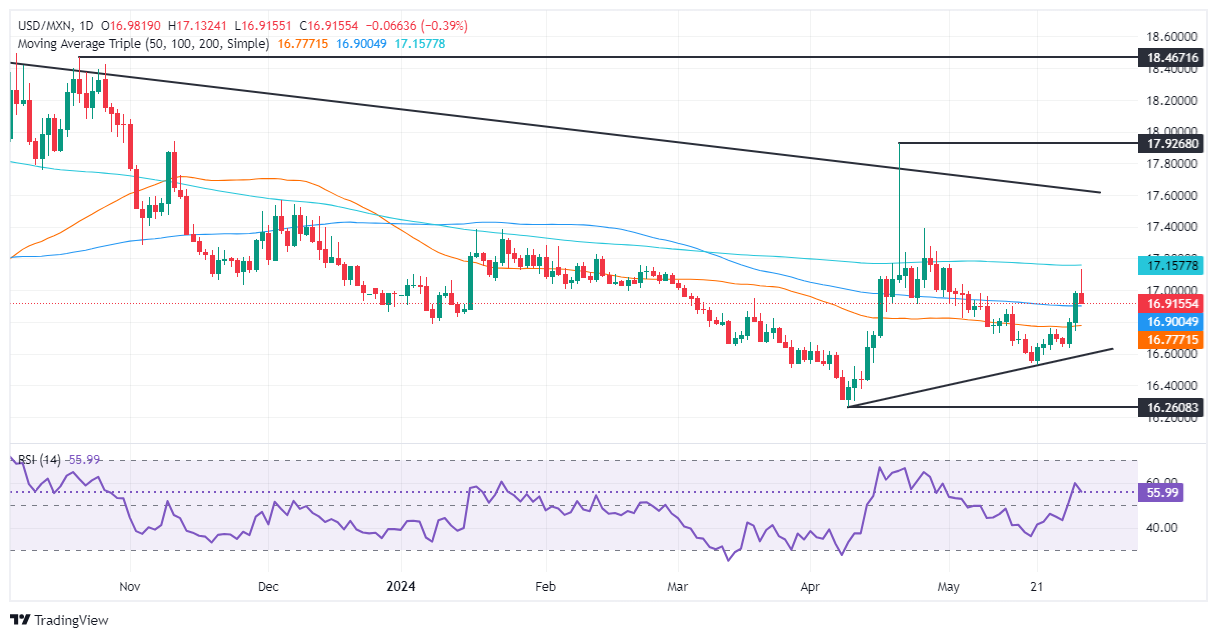For the latest news about the Mexican Peso click here.
- Mexican Peso strengthens to 16.92 after hitting four-week low of 17.13.
- US GDP data unchanged; higher unemployment claims suggest economic slowdown, weakening the US Dollar.
- Banxico revises inflation forecasts upward, hinting at potential split decision on rate cuts in June.
The Mexican Peso (MXN) erased some of its earlier losses against the US Dollar (USD) and rose some 0.20% after GDP data from the United States (US) showed the economy is slowing. Mexico’s economic docket featured the release of jobs data, which came as expected, and an improvement in risk appetite and a softer Greenback are a tailwind for the Mexican currency. The USD/MXN trades at 16.92 after reaching a four-week high of 17.13.
The US Bureau of Economic Analysis (BEA) revealed the Gross Domestic Product (GDP) second estimate for the first quarters, which was unchanged, aligned with the preliminary reading. At the same time, the US Bureau of Labor Statistics (BLS) revealed that the number of Americans filing for unemployment increased compared to expectations, an indication of weakness.
Following the data, US Treasury yields edged lower, while the US Dollar Index (DXY), which tracks the buck’s value against a basket of six currencies, erased Wednesday’s gains, down 0.41% at 104.68. That boosted the Peso, as the emerging market currency retreated below 17.00, strengthening sharply.
Mexico’s National Statistics Agency (INEGI) revealed that the labor market continued to cool down, according to April’s jobs data.
On Wednesday, the Bank of Mexico (Banxico) revealed its quarterly report, in which it revised its inflation forecasts upward. Elevated and stubbornly high inflation has split Banxico’s Governing Council.
Banxico sees headline inflation at 4% toward the end of 2024, up from 3.5% in its previous report. Underlying prices are foreseen to rise from 3.5% to 3.8%.
Banxico Governor Victoria Rodriguez Ceja added that progress in bringing inflation down has been made, adding that it will "assess the inflation outlook as a whole and [...] discuss adjustments to the reference rate at our next meetings.”
Goldman Sachs analysts suggested that the June meeting would be lively. They added, "If a rate cut does materialize, it will likely emanate from a split decision."
Meanwhile, traders brace for the release of April’s Personal Consumption Expenditures Price Index (PCE), the Federal Reserve’s (Fed) preferred inflation gauge. That, along with Mexico’s general election on Sunday, could dictate the USD/MXN path toward the second half of the year as the Mexican currency remains one of the strongest against the US Dollar.
Daily digest market movers: Mexican Peso on the offensive after soft US GDP data
- Mexico’s Unemployment Rate in April came as expected at 2.6%, up from 2.3% in March.
- The latest economic data from Mexico paint a mixed economic outlook. Although the economy continued to grow, higher prices and a widening trade deficit could depreciate the Mexican Peso.
- That and speculation of another Banxico rate cut in June could pave the way for further upside in the USD/MXN.
- May’s Citibanamex poll showed that most economists estimate Banxico will cut rates on June 27 from 11% to 10.75%. The median expects headline inflation at 4.21% and core at 4.07% in 2024.
- US economic docket featured the second estimate of Gross Domestic Product (GDP) for Q1 2024, which dipped from 3.4% to 1.3% QoQ, as analysts expected.
- Initial Jobless Claims for the week ending May 25 rose by 219K, exceeding the consensus 218K and the previous 216K reading.
- Despite that, fed funds rate futures estimated 27 basis points of easing toward the end of the year.
Technical analysis: Mexican Peso appreciates as USD/MXN tumbles back below 17.00
The USD/MXN downtrend remains in play, although buyers gathered steam and pushed the exchange rate toward 17.13, shy of testing the 200-day Simple Moving Average (SMA) at 17.14. Momentum remains bullish, yet buyers are taking a breather after lifting prices close to 3% in three days, trumped by weak US data.
If buyers regain 17.00, that could pave the way to challenging the weekly high of 17.13. Once cleared, the 200-day SMA at 17.14 would be next, ahead of challenging the December 7 high of 17.56, followed by the psychological 18.00 figure.
On the other hand, a bearish continuation would happen if sellers kept the exchange rate below the 100-day SMA, which could pave the way for a dip to the 2023 low of 16.62, followed by the May 21 cycle low at 16.52 and the year-to-date low of 16.25.














